Brief collection completed - 1876 Proof Trade Dollars
 MilkmanDan
Posts: 3,764 ✭✭✭✭✭
MilkmanDan
Posts: 3,764 ✭✭✭✭✭
Half way through the U.S. Trade Dollar series(1873-1878 for circulation strikes), during the years 1875 and 1876, the obverse and reverse hubs were re-worked and new dies created in an attempt to improve striking quality. Although the original intent of the U.S. Trade Dollar was for the coin to be used as bullion for commercial purposes in the Orient, proof issue coins were struck from 1873 through 1885, outlasting the circulation strikes by 7 years.
During the year 1875, a new reverse hub type was introduced, removing the berry from underneath the eagle's right claw and slightly reworking the neck of the eagle. This year includes two proof issues, the Type I/I and Type I/II (obverse/reverse) varieties. During the year 1876, the obverse hub type was also updated to add a 4th finger to Liberty's outstretched hand as well as a lengthening of the end of the Liberty Scroll tips pointing downward instead of to the left. This year includes four different varieties, the Type I/I, Type I/II, Type II/II and a scarce "transitional" die exhibiting a Type I obverse, but with 4 fingers on Liberty's outstretched hand. Speaking exclusively about PROOF issues, the Type I/I issue is very rare, the Type I/II is common, while the Type I/II 4 finger and Type II/II are scarce.
This brief collection covers the year 1876, the only year to include all 4 hub types/varieties. I am happy to report this collection was recently completed, all with coins that met the bar for eye appeal. Well, the Type I/I isn’t amazing, but there aren't many known so at least it's not cleaned!
My hope is that this thread can be an educational resource, as anyone thinking of collecting Trade Dollars should first familiarize themself with the different obverse and reverse hub types.
Type I/I Proof
Type I/I. Although later 1875 issues had transitioned to the Type II reverse, some Type I reverse dies were used in 1876. Even more interesting is this particular reverse, known informally as the "broken letters reverse" exhibits missing serifs on the reverse USofA letters. It is unknown why this happened but I find it fascinating that such an imperfect die was used to mint proof coinage. Trade dollars of 1876 are notoriously difficult to distinguish when determining circulation strike vs. proof strike origin. Fortunately, despite a weakish reverse strike this coin leaves no question, it was no doubt struck as a proof. The beads in Liberty's head-dress are very well defined, as are the obverse stars. The obverse and reverse fields are brightly mirrored and unpolished areas below Liberty's chin and armpit exhibit contrast. The coin also shares a few minor pick up points also seen on other no-doubt proof examples. Both Breen and Bowers estimated 4 known in their respective encyclopedias, since publication a few more have been discovered with approx. 8 to 10 known today. I estimate that around 5% of survivors, maybe less, of all 1876 proofs are of the Type I/I variety.
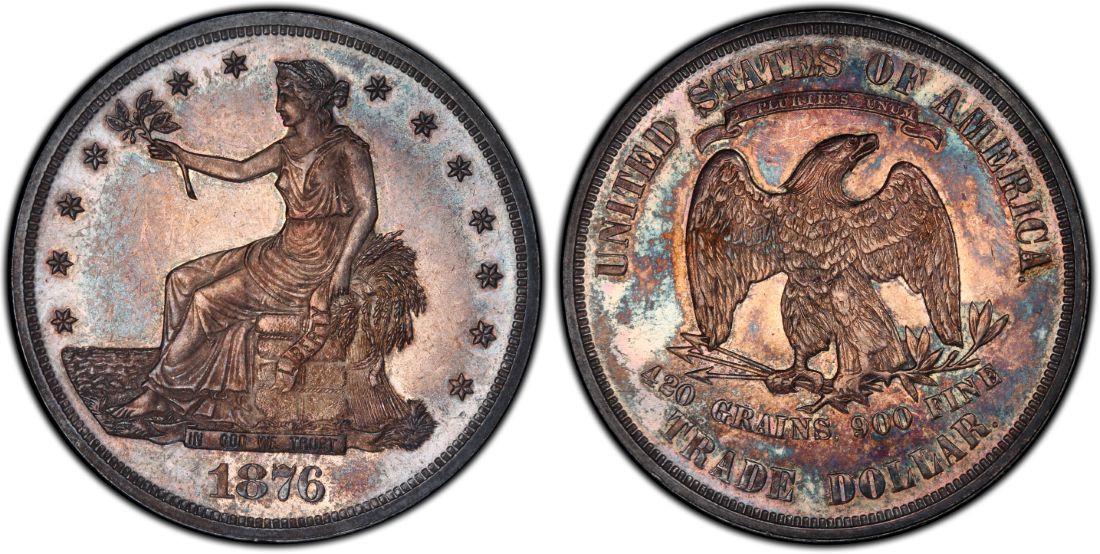

Type I/II Proof
The most common type, I estimate 75% of survivors are this type. Interesting that this was the last coin I added to the set. Focus attention on the reverse, compared to the above coin. You'll notice the missing berry between the eagles talon, the easiest way to recognize the Type II reverse.
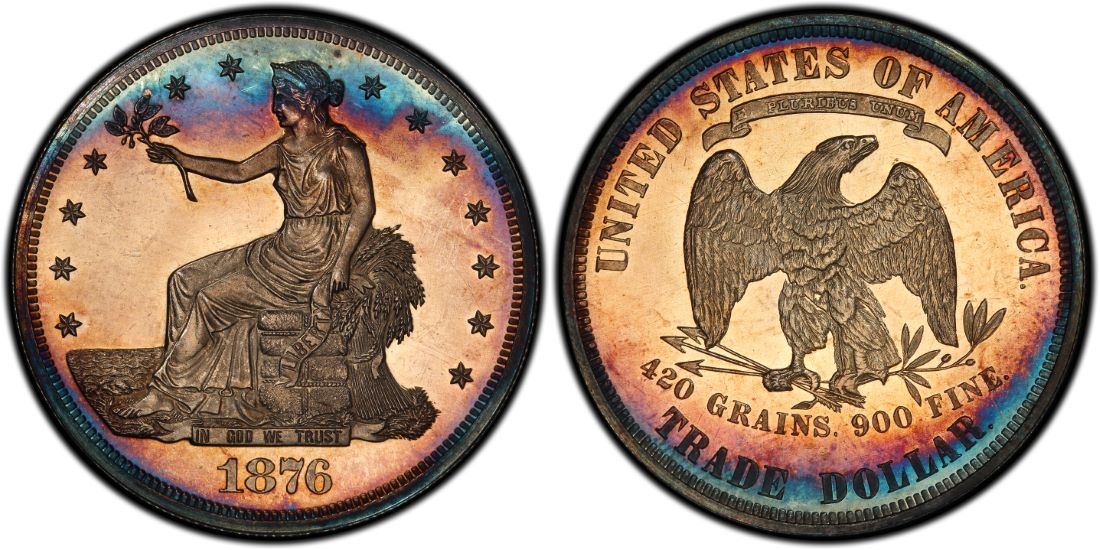
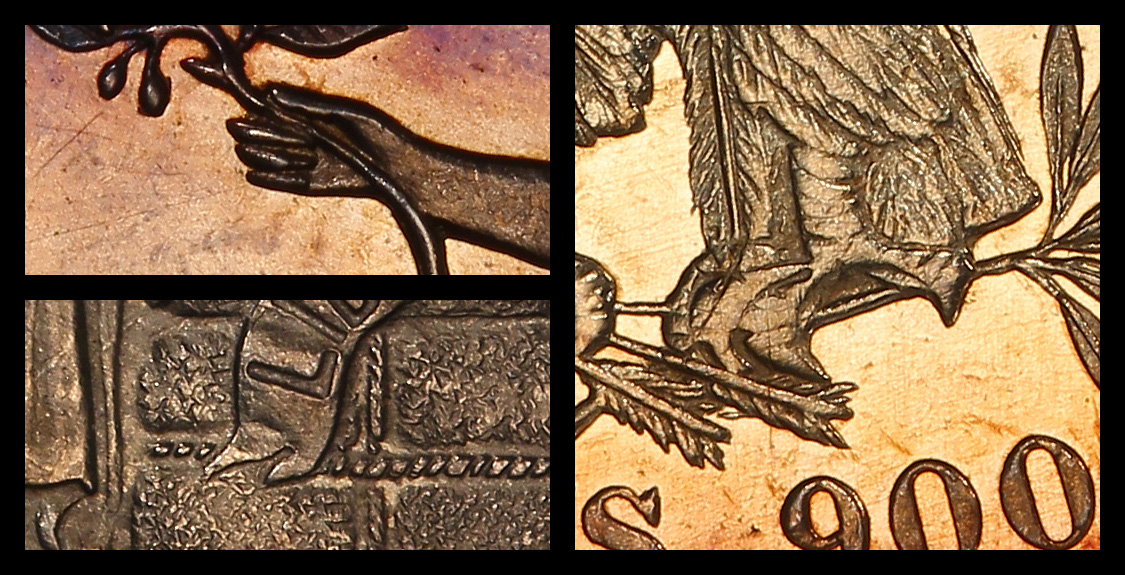
Transitional Type I.5/II Proof
Note the obverse shows the liberty scroll tips pointing down and to the left, as normally seen on a Type I obverse. However, Liberty's outstretched hand shows 4 fingers, as normally seen on a Type II obverse. It is unknown how or why this die came to be, whether it was an experimental die, an accidental mistake, or something else. I estimate that about 10% of all 1876 proofs are of this Type I/II 4 Finger variety. This particular example is exceptionally made, with very bold details, quite mirrored surfaces and frosty devices. Of note, there also exist very poorly made examples of this variety, with mirrored surfaces but flatness throughout the obverse and reverse, especially in the stars. I called this a "transitional" variety because we really don't know what it is. It could have been a simple mistake, possibly an "experimental" issue akin to a pattern, or something else altogether.
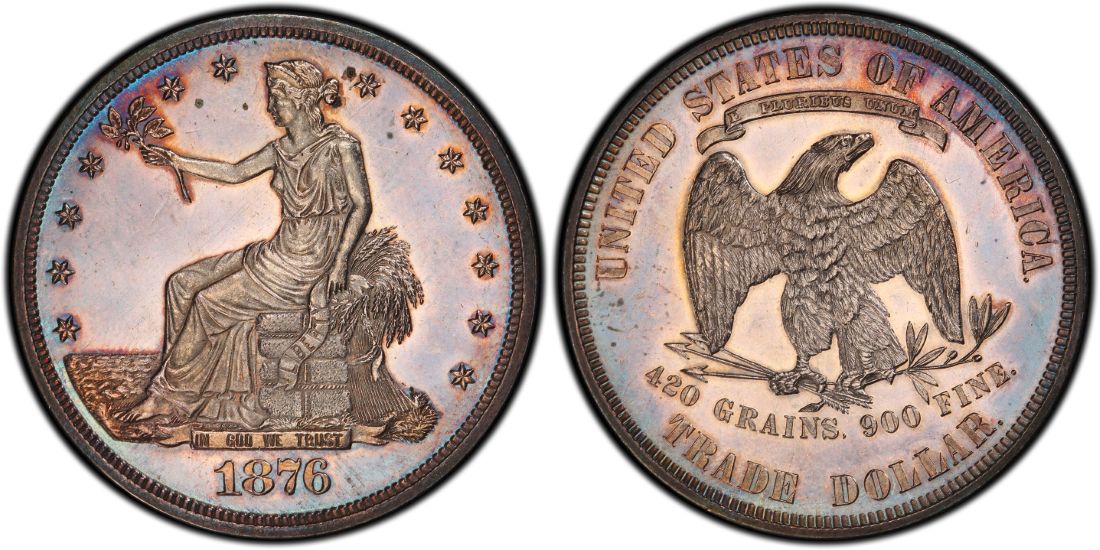
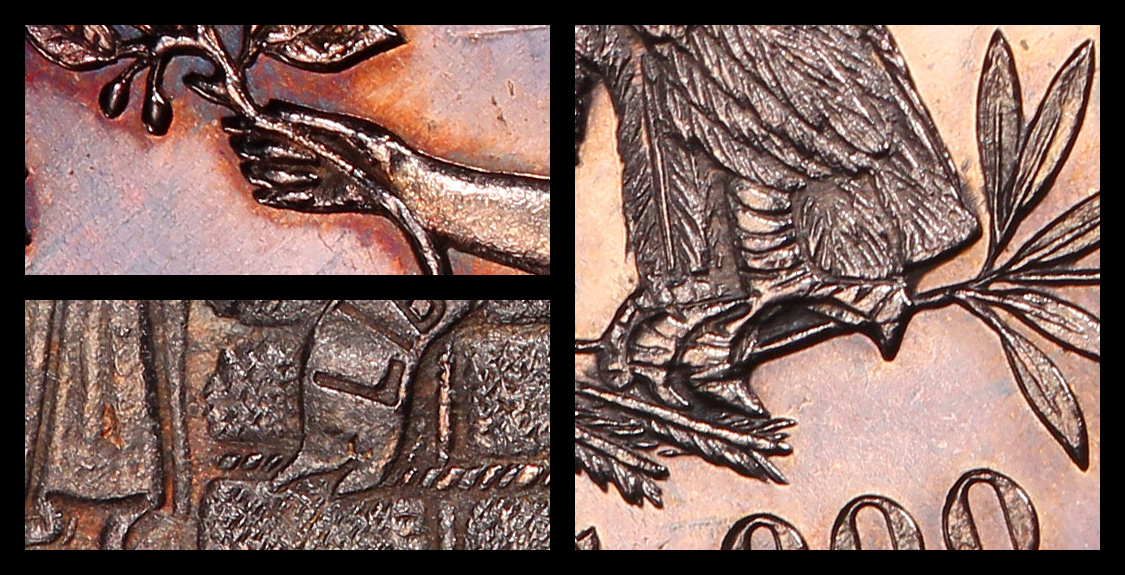
Type II/II Proof
This hub type is popular because its circulation strike twin is a well known key to the Trade Dollar variety set. I estimate that about 10% of the 76 proof trade dollars are of the Type II/II variety. This is one of my favorite coins, period.
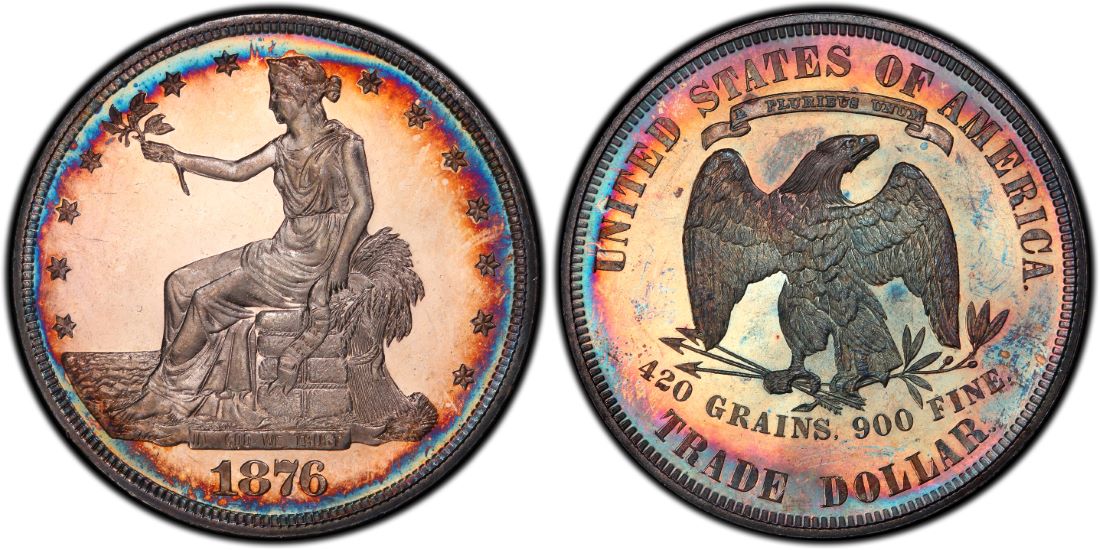
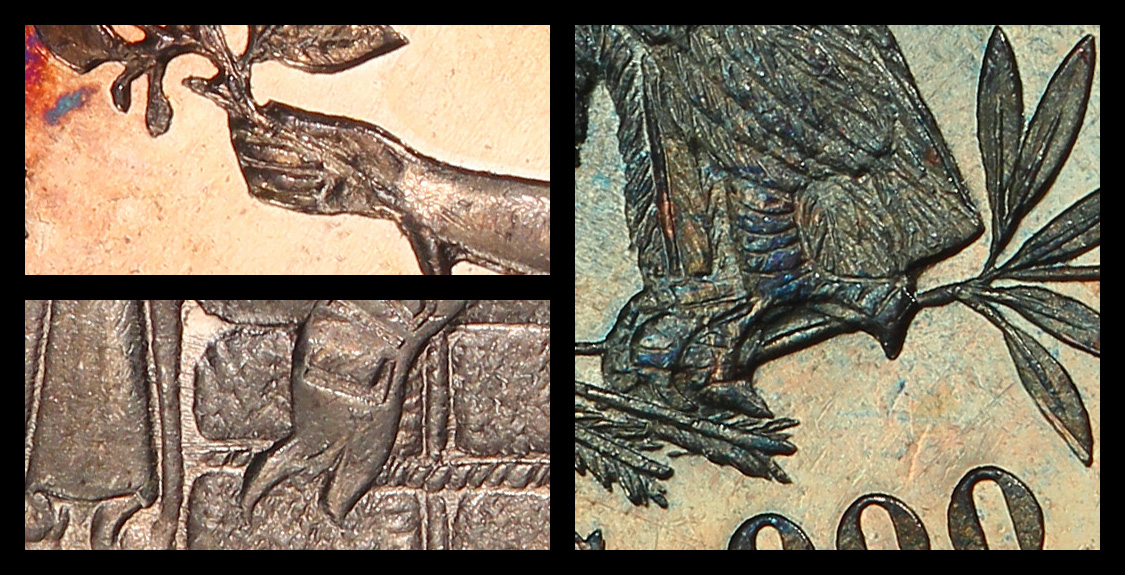
Hope you enjoy. This was a fun set to put together.
UPDATE:
A few things you might find interesting:
- I would have never attempted this set, had I not stumbled upon the Type I/I proof as a "buy it now" listed on Heritage offered at a really fair price. Once I had that one in hand and confirmed it was really a proof, I knew the set was achievable.
- All 4 of the above hub types/varieties are also found as circulation strikes. The scarcity/rarity as circulation strikes is completely different than these proofs, although the Type I/II is also the most common as a circulation strike.
- The I.5/II variety shares the same reverse die as the II/II for every example known, both proof and circulation strike. Interestingly, I found a type I/II circulation strike that also shares this reverse die, however there are no known type I/II proofs that used this reverse die. This adds a bit of mystique to these coins, there was obviously something special about the reverse die as it was mated to three different obverses and used to make both proof and circulation strike coins.
During the year 1875, a new reverse hub type was introduced, removing the berry from underneath the eagle's right claw and slightly reworking the neck of the eagle. This year includes two proof issues, the Type I/I and Type I/II (obverse/reverse) varieties. During the year 1876, the obverse hub type was also updated to add a 4th finger to Liberty's outstretched hand as well as a lengthening of the end of the Liberty Scroll tips pointing downward instead of to the left. This year includes four different varieties, the Type I/I, Type I/II, Type II/II and a scarce "transitional" die exhibiting a Type I obverse, but with 4 fingers on Liberty's outstretched hand. Speaking exclusively about PROOF issues, the Type I/I issue is very rare, the Type I/II is common, while the Type I/II 4 finger and Type II/II are scarce.
This brief collection covers the year 1876, the only year to include all 4 hub types/varieties. I am happy to report this collection was recently completed, all with coins that met the bar for eye appeal. Well, the Type I/I isn’t amazing, but there aren't many known so at least it's not cleaned!
My hope is that this thread can be an educational resource, as anyone thinking of collecting Trade Dollars should first familiarize themself with the different obverse and reverse hub types.
Type I/I Proof
Type I/I. Although later 1875 issues had transitioned to the Type II reverse, some Type I reverse dies were used in 1876. Even more interesting is this particular reverse, known informally as the "broken letters reverse" exhibits missing serifs on the reverse USofA letters. It is unknown why this happened but I find it fascinating that such an imperfect die was used to mint proof coinage. Trade dollars of 1876 are notoriously difficult to distinguish when determining circulation strike vs. proof strike origin. Fortunately, despite a weakish reverse strike this coin leaves no question, it was no doubt struck as a proof. The beads in Liberty's head-dress are very well defined, as are the obverse stars. The obverse and reverse fields are brightly mirrored and unpolished areas below Liberty's chin and armpit exhibit contrast. The coin also shares a few minor pick up points also seen on other no-doubt proof examples. Both Breen and Bowers estimated 4 known in their respective encyclopedias, since publication a few more have been discovered with approx. 8 to 10 known today. I estimate that around 5% of survivors, maybe less, of all 1876 proofs are of the Type I/I variety.


Type I/II Proof
The most common type, I estimate 75% of survivors are this type. Interesting that this was the last coin I added to the set. Focus attention on the reverse, compared to the above coin. You'll notice the missing berry between the eagles talon, the easiest way to recognize the Type II reverse.


Transitional Type I.5/II Proof
Note the obverse shows the liberty scroll tips pointing down and to the left, as normally seen on a Type I obverse. However, Liberty's outstretched hand shows 4 fingers, as normally seen on a Type II obverse. It is unknown how or why this die came to be, whether it was an experimental die, an accidental mistake, or something else. I estimate that about 10% of all 1876 proofs are of this Type I/II 4 Finger variety. This particular example is exceptionally made, with very bold details, quite mirrored surfaces and frosty devices. Of note, there also exist very poorly made examples of this variety, with mirrored surfaces but flatness throughout the obverse and reverse, especially in the stars. I called this a "transitional" variety because we really don't know what it is. It could have been a simple mistake, possibly an "experimental" issue akin to a pattern, or something else altogether.


Type II/II Proof
This hub type is popular because its circulation strike twin is a well known key to the Trade Dollar variety set. I estimate that about 10% of the 76 proof trade dollars are of the Type II/II variety. This is one of my favorite coins, period.


Hope you enjoy. This was a fun set to put together.
UPDATE:
A few things you might find interesting:
- I would have never attempted this set, had I not stumbled upon the Type I/I proof as a "buy it now" listed on Heritage offered at a really fair price. Once I had that one in hand and confirmed it was really a proof, I knew the set was achievable.
- All 4 of the above hub types/varieties are also found as circulation strikes. The scarcity/rarity as circulation strikes is completely different than these proofs, although the Type I/II is also the most common as a circulation strike.
- The I.5/II variety shares the same reverse die as the II/II for every example known, both proof and circulation strike. Interestingly, I found a type I/II circulation strike that also shares this reverse die, however there are no known type I/II proofs that used this reverse die. This adds a bit of mystique to these coins, there was obviously something special about the reverse die as it was mated to three different obverses and used to make both proof and circulation strike coins.
12
Comments
Thank you.
Your a real specialist.
I give away money. I collect money.
I don’t love money . I do love the Lord God.
mbogoman
https://pcgs.com/setregistry/collectors-showcase/classic-issues-colonials-through-1964/zambezi-collection-trade-dollars/7345Asesabi Lutho
Stuart
Collect 18th & 19th Century US Type Coins, Silver Dollars, $20 Gold Double Eagles and World Crowns & Talers with High Eye Appeal
"Luck is what happens when Preparation meets Opportunity"
.
CoinsAreFun Toned Silver Eagle Proof Album
.
Gallery Mint Museum, Ron Landis& Joe Rust, The beginnings of the Golden Dollar
.
More CoinsAreFun Pictorials NGC FOR SALE
How does one get a hater to stop hating?
I can be reached at evillageprowler@gmail.com
Tremendous post.
Thanks!
"Inspiration exists, but it has to find you working" Pablo Picasso
<< <i>Love what I see, Dan....great images....and very informative Trade $1 thread.....most welcomed here.
Thank you. >>
- Marcus Tullius Cicero, 106-43 BC
<< <i>Love what I see, Dan....great images....and very informative Trade $1 thread.....most welcomed here.
Thank you. >>
Well said and I agee. I have bookmarked this for future needs. Thank you for sharing.
Looking for Top Pop Mercury Dime Varieties & High Grade Mercury Dime Toners.
Complete Set of Chopmarked Trade Dollars
Carson City Silver Dollars Complete 1870-1893http://www.pcgs.com/setregistry/showcase.aspx?sc=2722"
"Everything is on its way to somewhere. Everything." - George Malley, Phenomenon
http://www.american-legacy-coins.com
I've added a little more meat to the OP for clarification and added a few interesting points at the bottom to discuss the relation to circulation strikes.
<< <i>"Transitional" is speculative for the so-called T1.5 obverse. >>
Well, yes and no. I tried to make it clear that we don't know what this variety really is or why it was made. It is transitional in the sense that it shows attributes from both the Type I and Type II obverse types. But to be very clear, it has not been proven that the Type I.5 obverse coins were created "in between" the Type I and Type II coins. In theory it should be possible to prove/dis-prove this because of the shared reverse die, but doing a die progression study of these coins would be next to impossible. There aren't enough specimens to study period, let alone high grade examples.
<< <i>Thank you all for the comments. Glad to see no one called me nuts for doing this set, or maybe you are all too nice.
I've added a little more meat to the OP for clarification and added a few interesting points at the bottom to discuss the relation to circulation strikes.
<< <i>"Transitional" is speculative for the so-called T1.5 obverse. >>
Well, yes and no. I tried to make it clear that we don't know what this variety really is or why it was made. It is transitional in the sense that it shows attributes from both the Type I and Type II obverse types. But to be very clear, it has not been proven that the Type I.5 obverse coins were created "in between" the Type I and Type II coins. In theory it should be possible to prove/dis-prove this because of the shared reverse die, but doing a die progression study of these coins would be next to impossible. There aren't enough specimens to study period, let alone high grade examples. >>
I'm a big fan of small focused sets and detailed historical information so this is one that I really appreciate. I love the research and close up photos. Great collection
<< <i>Thank you all for the comments. Glad to see no one called me nuts for doing this set, or maybe you are all too nice.
I've added a little more meat to the OP for clarification and added a few interesting points at the bottom to discuss the relation to circulation strikes.
<< <i>"Transitional" is speculative for the so-called T1.5 obverse. >>
Well, yes and no. I tried to make it clear that we don't know what this variety really is or why it was made. It is transitional in the sense that it shows attributes from both the Type I and Type II obverse types. But to be very clear, it has not been proven that the Type I.5 obverse coins were created "in between" the Type I and Type II coins. In theory it should be possible to prove/dis-prove this because of the shared reverse die, but doing a die progression study of these coins would be next to impossible. There aren't enough specimens to study period, let alone high grade examples. >>
Is it possible known T1.5obv are a re-lapped state of T1obv? I am wondering if the mint staff may have "fixed" (or whatever word you choose) the extended hand to resemble a T2obv while they were re-polishing the T1obv die. Are the known T1.5obv specimens obviously PF, or can they be strongly PL? If the latter, I'd compare the T1.5obv dies to MS T1obv dies too. (After all, MS 1876 TD's are not uncommonly seen PL.)
EVP
How does one get a hater to stop hating?
I can be reached at evillageprowler@gmail.com
<< <i> Is it possible known T1.5obv are a re-lapped state of T1obv? I am wondering if the mint staff may have "fixed" (or whatever word you choose) the extended hand to resemble a T2obv while they were re-polishing the T1obv die. Are the known T1.5obv specimens obviously PF, or can they be strongly PL? If the latter, I'd compare the T1.5obv dies to MS T1obv dies too. (After all, MS 1876 TD's are not uncommonly seen PL.)
EVP >>
It's certainly possible, but my research hasn't shown this to be true. Trust me, I've looked! Based on the evidence I've studied, the die for the type I.5 wasn't used long, for a small production run of proof and business strikes. It does not appear to be a modified version of a previously used die.
When I started looking I fully expected to find a die match without the finger, but after much looking and study I am convinced this die is somehow special. It's an oddball type, was used for proof and circulation strikes, wasn't used long, and shares a reverse with two other obverses.
<< <i>I'm a big fan of small focused sets and detailed historical information so this is one that I really appreciate. I love the research and close up photos. Great collection
Thanks! A dream of mine is to find historical mint records that provide insight into TD production in 1876. Officially there were 1200 proof coins manufactured but evidence shows the mint may have "good enoughed" a few extras, possibly due to increased demand in the centennial year. There's also the strange existence of these 4 different proof varieties in a single year - I'm close to matching up the production numbers and months with each of the varieties but would need a little more evidence to be sure. I've been in brief contact with Roger Burdette who has helped point me in the right direction. It's fun to keep the focus really narrow and go deep in study of the coins and their history.
Andrew Blinkiewicz-Heritage
How did I miss this
11.5$ Southern Dollars, The little “Big Easy” set
That is a very good question! It is 6 years old - maybe you just forgot at your age! (my age, too, or close enough!) It's one of my favorite posts - that's why I have it bookmarked for reference purposes. It was a great job by Dan and excellent pics accompanying it. I thought the OP in the other 1876 thread would appreciate it...
(my age, too, or close enough!) It's one of my favorite posts - that's why I have it bookmarked for reference purposes. It was a great job by Dan and excellent pics accompanying it. I thought the OP in the other 1876 thread would appreciate it...
mbogoman
https://pcgs.com/setregistry/collectors-showcase/classic-issues-colonials-through-1964/zambezi-collection-trade-dollars/7345Asesabi Lutho
Affirmative
Excellent old thread - especially useful for those with Trade Dollar collections.... Cheers, RickO
The Proof and BS 76p (4finger or) 1.5 have different reed counts that at the very least prove different striking emissions
11.5$ Southern Dollars, The little “Big Easy” set
This is a really great thread, and Dan is an astute numismatist. The 1876 Trade Dollar is a very interesting date, and Dan adds to the hobby with his in- depth analysis. I particularly love the J. Stack pedigreed 1876 proof Type II/II.....A gorgeous specimen.
This thread brings back some great memories. Glad you guys find it helpful. This date is still the most fascinating in my opinion, for the series.
wonderful post and worthy of a POTD.
lovely images and presentation sir@!